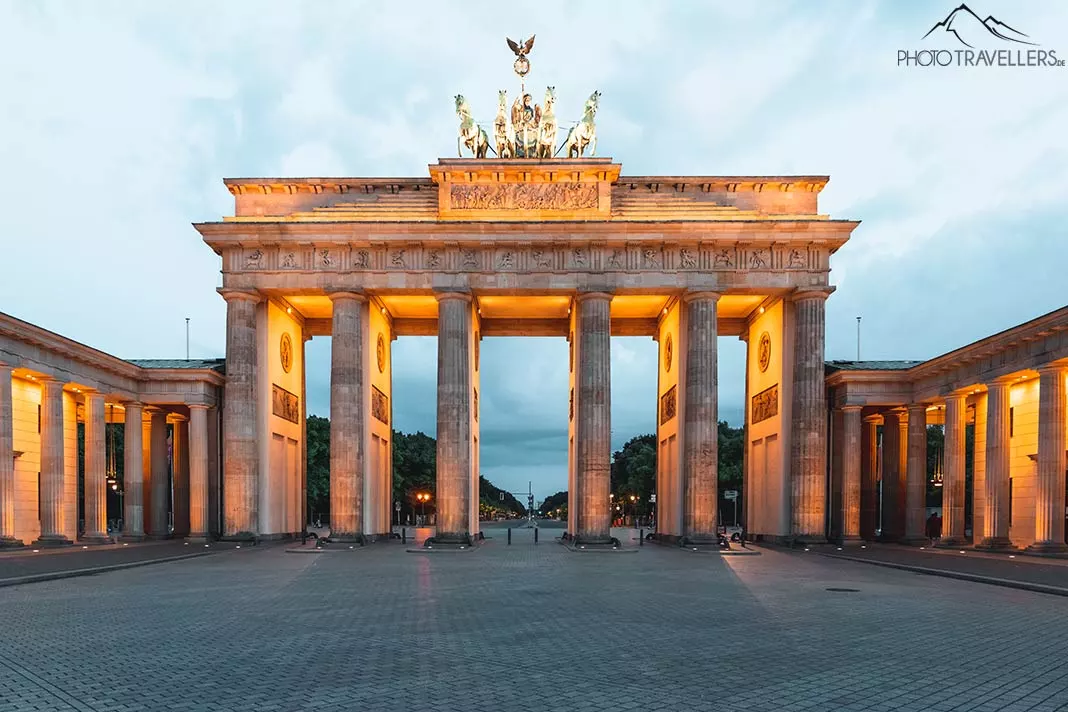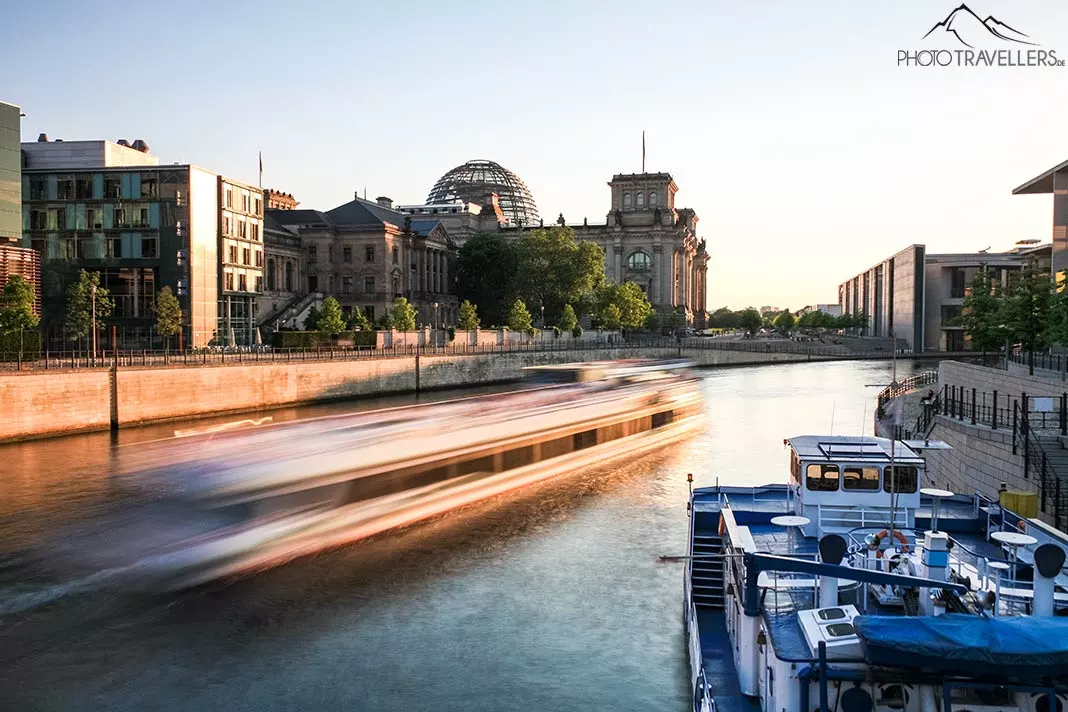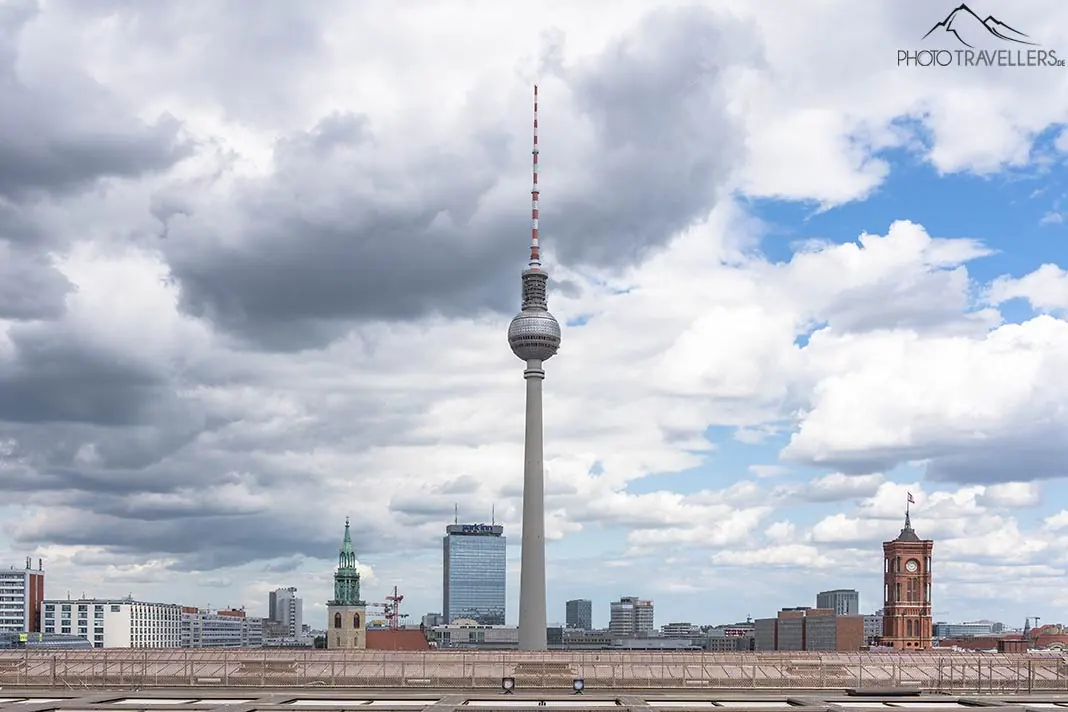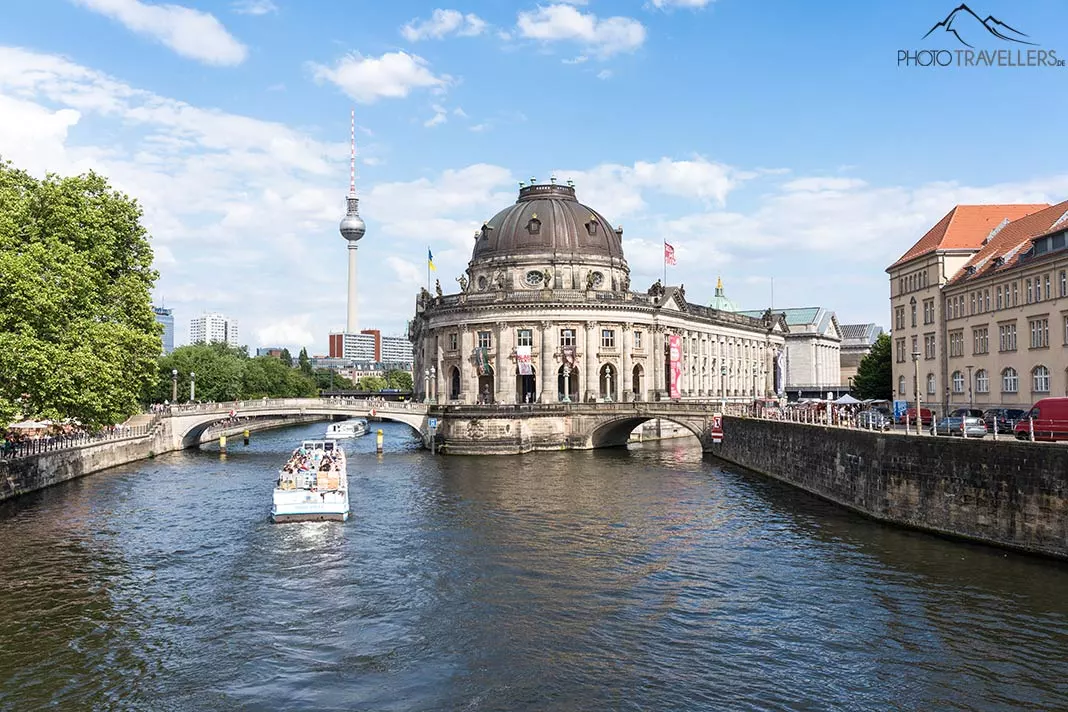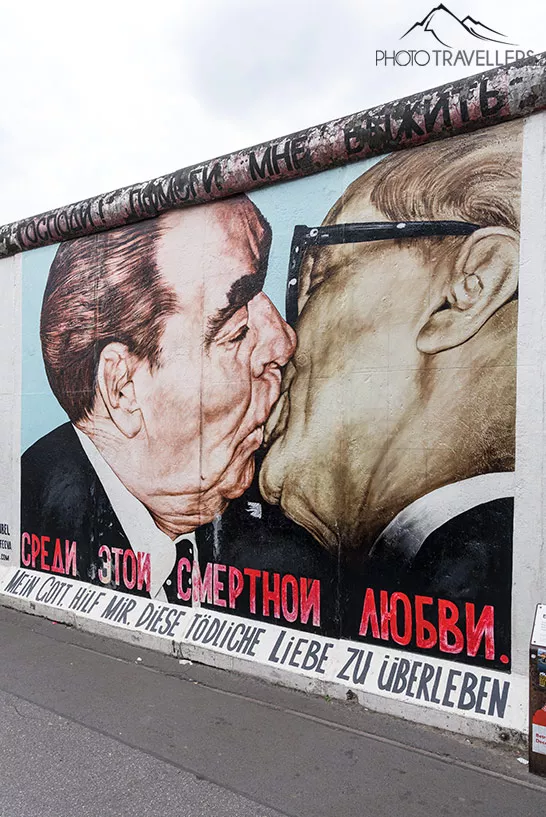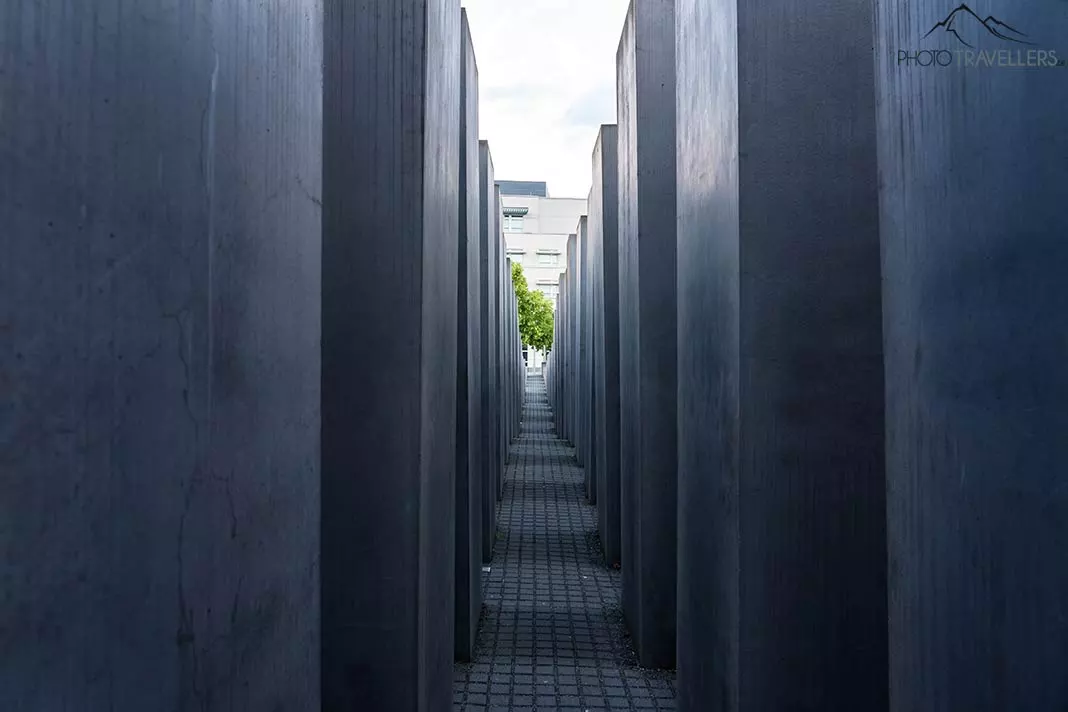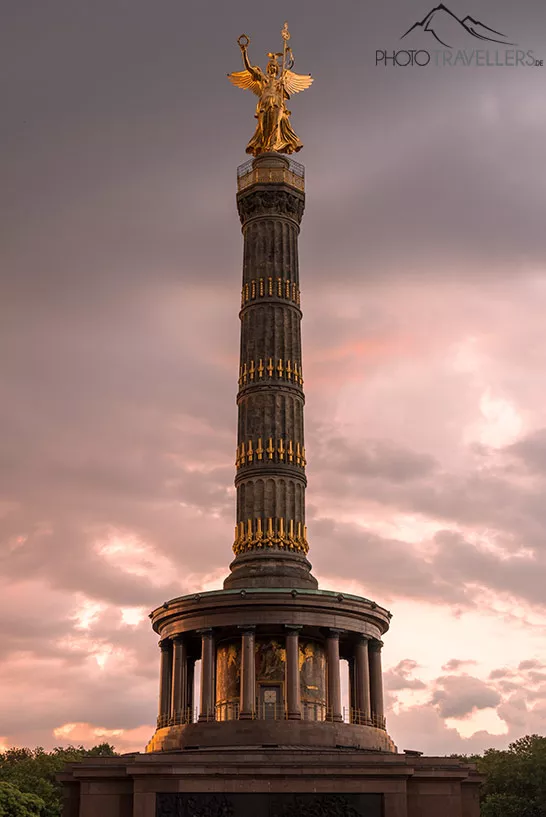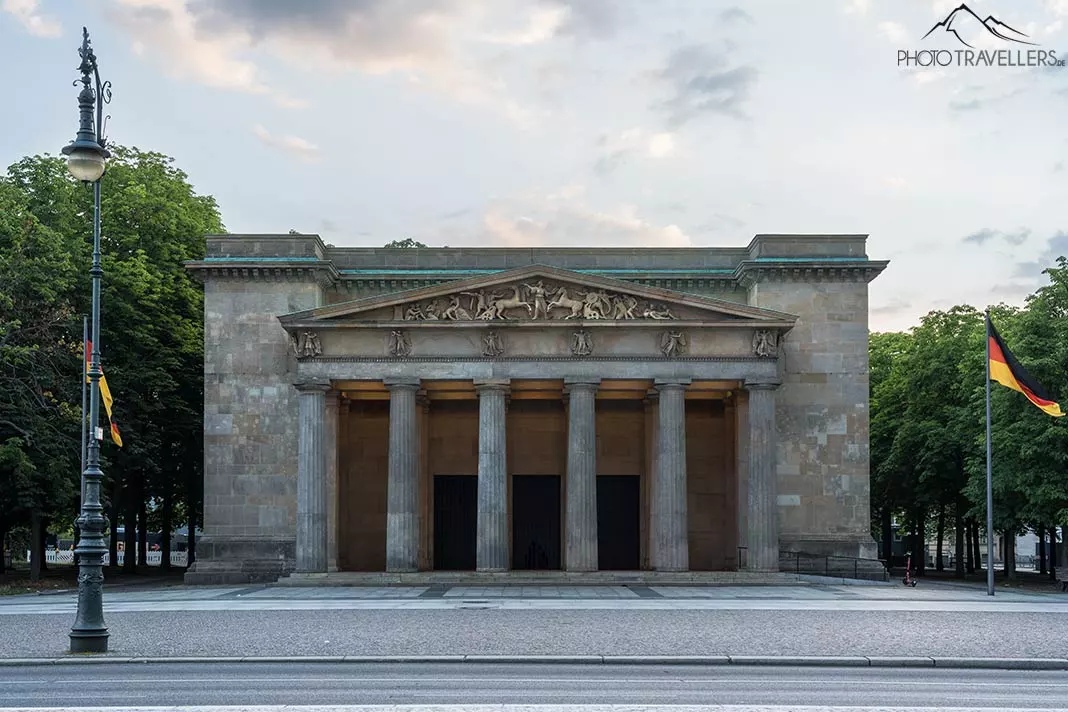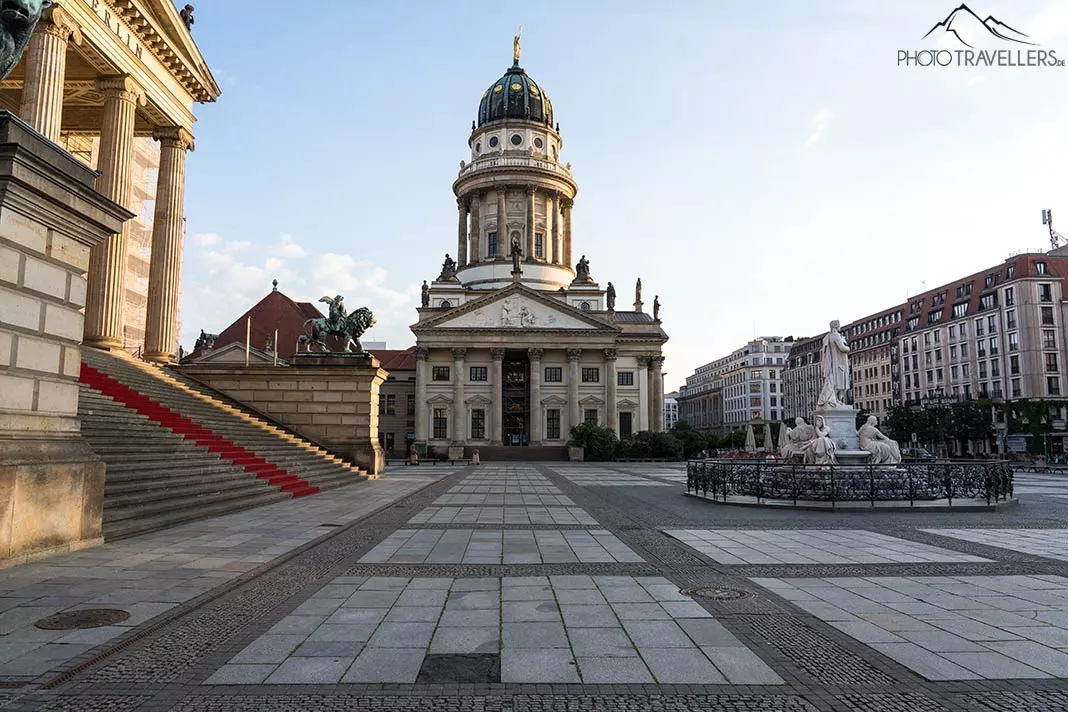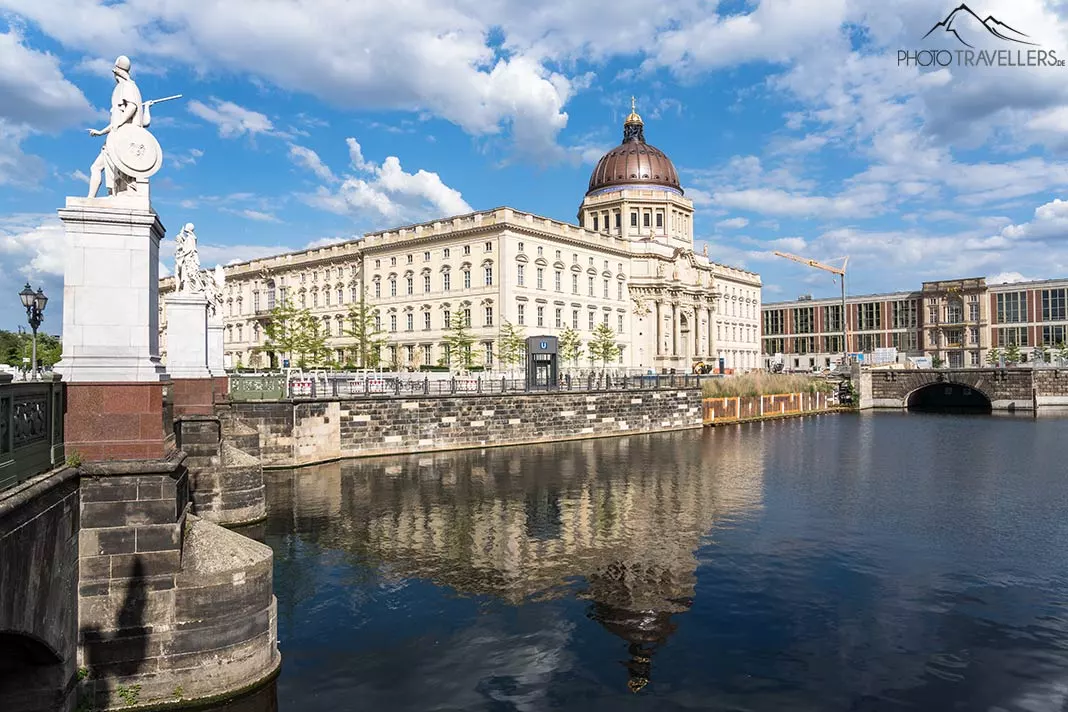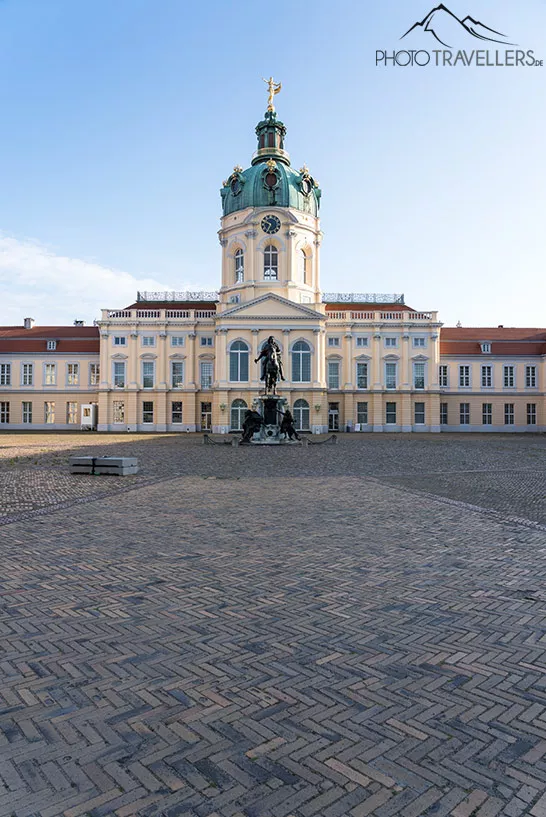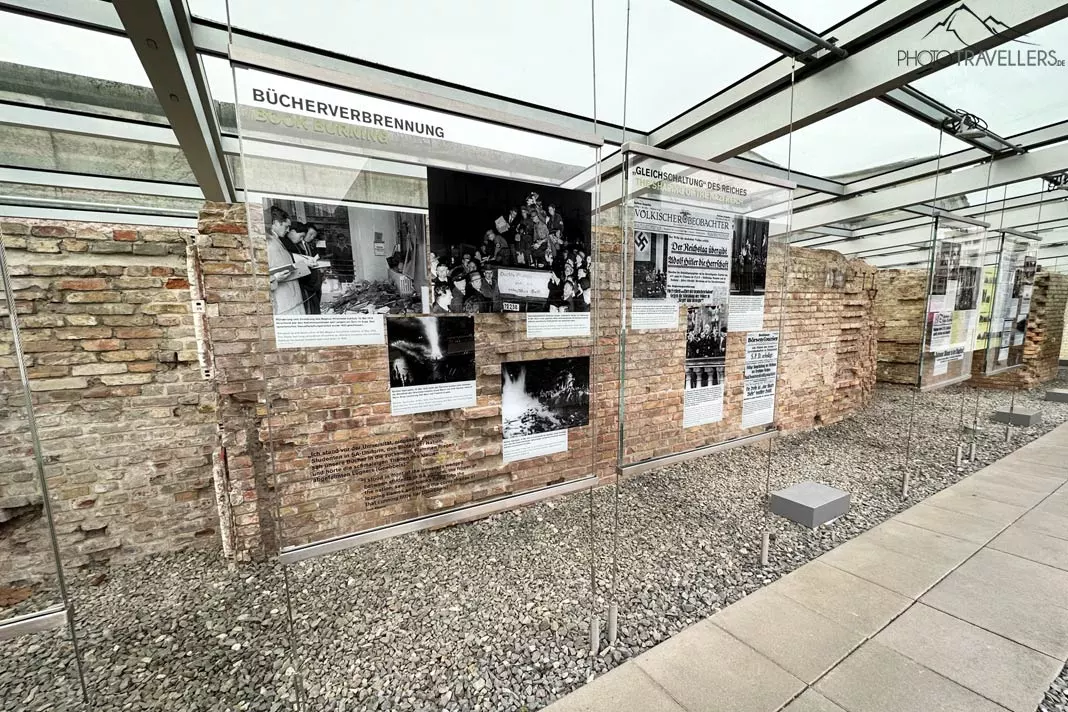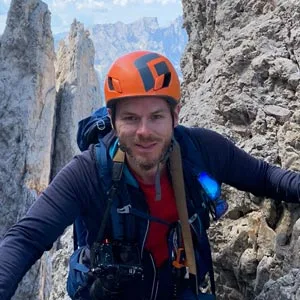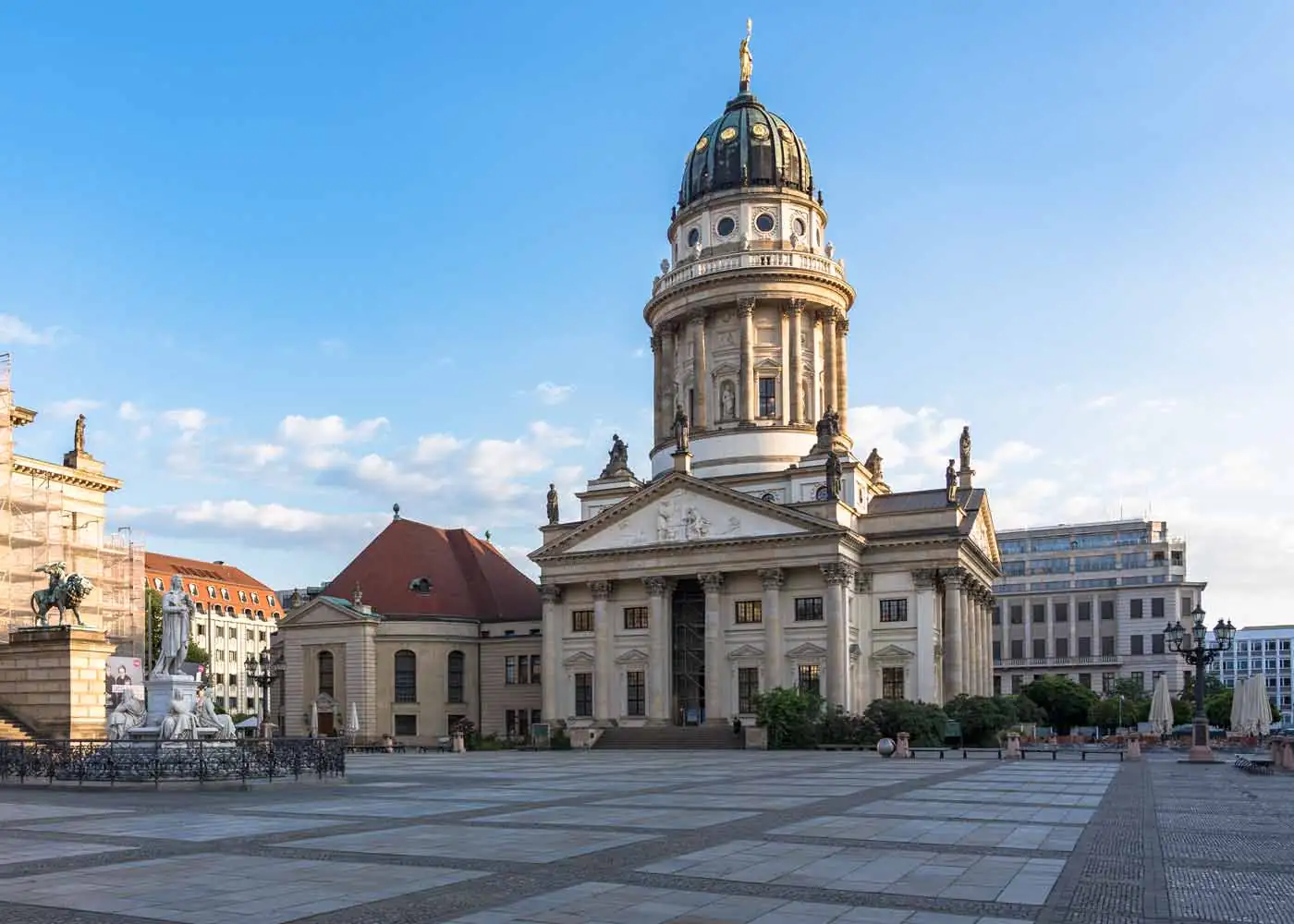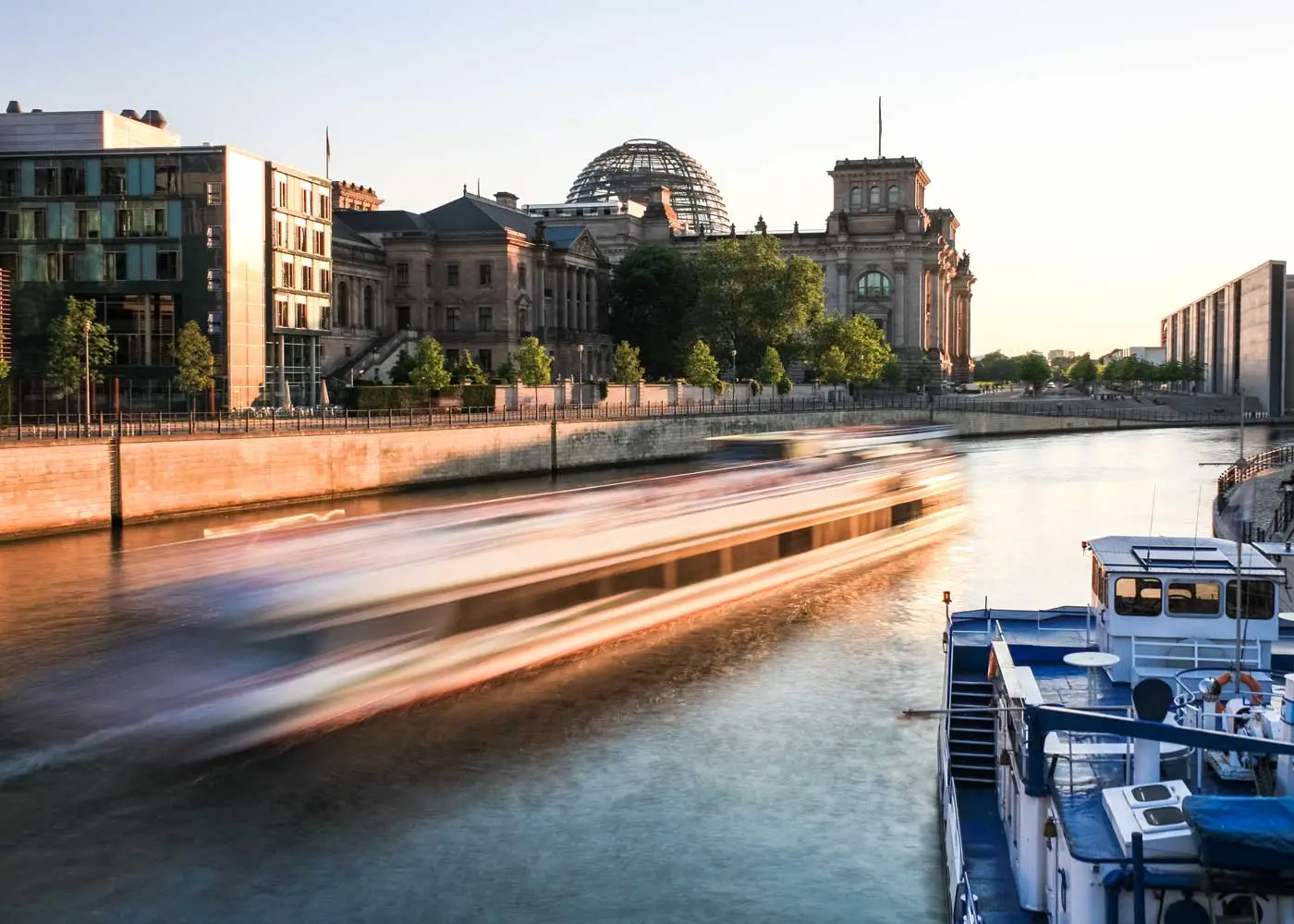
15 best things to do in Berlin for 2023
Berlin is one of the most exciting cities in Germany. We take you on a fascinating journey through the German capital and show you the most important sights.
We'll tell you everything you need to see in Berlin and which highlights you absolutely mustn't miss!
Whether you're interested in art and culture or simply curious about Berlin's vibrant life, you'll find the best Berlin tips here.

Hi! Wir sind Biggi & Flo
Wir nehmen dich als Reisejournalisten mit zu den schönsten Orten der Welt!
Werbehinweis: Alle mit einem * markierten Links sind Werbelinks.
At a glance: What to do in Berlin
Brandenburg Gate: the symbol of German unity and a masterpiece of architecture
Reichstag building: an impressive testimony to German history. The glass dome offers a breathtaking view over the city
Alexanderplatz with TV tower: the heart of the metropolis and a paradise for shopaholics. And the television tower? A landmark you can’t miss
Museum Island: An Eldorado for art and culture lovers. Five museums on one island!
That was just a small taste of what you can see and do in Berlin. You can easily explore the city and most of the attractions on foot and by bus and train. We recommend planning at least two to three days for Berlin’s top highlights. At the end of the article you will find our map with all Berlin sights.
You can find an overview of the most beautiful places in Berlin here.
1. Brandenburg Gate
Together with the rebuilt Pariser Platz, the Brandenburg Gate is Berlin’s most famous sight. Thousands of visitors stand in front of the historic city gate every day to take pictures.
But why is the Brandenburg Gate so famous? The gate is the only one of Berlin’s 18 city gates that has survived. Important events such as the end of Napoleonic rule, the celebration of Constitution Day in the Weimar Republic and the fall of the Berlin Wall are associated with the imposing building.
During the division of the city into West and East Berlin from 1961 to 1989, the Brandenburg Gate was located directly behind the border line in the Soviet sector in the so-called no-man’s land – access was impossible.
Tip: By the way, we love exploring foreign cities not only on our own, but also on a city tour with a guide*.
2. Reichstag
The next highlight is just a stone’s throw away from the Brandenburg Gate. Just 400 meters away is the Reichstag building, also known as the Reichstag or Bundestag , which has been the seat of the Bundestag since 1999.
The “trademark” of the Reichstag building is the walk-in glass dome above the plenary chamber of the German Bundestag. If you would like to visit the glass dome designed by star architect Norman Foster and the accompanying roof terrace, you must register here free of charge and book an appointment for a guided tour (there are also guided tours for children in the Bundestag). Guided tours of the Bundestag are often fully booked weeks in advance. You should therefore reserve tickets early.
You can also book a guided tour of the government district* with all kinds of interesting facts.
3. Television tower on “Alex”
At 368 meters, the Berlin television tower on Alexanderplatz, or “Alex” for short, is the tallest building in Germany and one of Berlin’s most famous landmarks. The ride in the express elevator is an experience in itself. The elevator takes you to a height of over 200 meters in just 40 seconds.
From the viewing platform at a height of 203 meters, you have a great view over Berlin. You can enjoy a 360-degree view of the skyline through the 60 panoramic windows. In Bar 203, you can sip a cool drink and soak up the cosmopolitan flair.
The Sphere revolving restaurant is also located at a height of 207 meters. Make sure you reserve a window seat (book your ticket*). Or how about breakfast in the revolving restaurant in the TV tower (book your ticket*)?
Incidentally, the Alex, formerly and today the center of “East Berlin”, is the most famous square in the city. Highlights on the Alex include the television tower, the famous World Time Clock, the Berolina (a statue of a woman with an oak wreath symbolizing the city of Berlin) and the Rotes Rathaus, seat of the mayor and meeting place of the Berlin Senate.
Tip: From the panorama terrace of the Hotel Park Inn (6 euros admission) at a height of 120 meters, you have a great view of the TV tower and the Alex.
Tip 2: Bus line 100 is the tourist line par excellence. Line 100 runs between the Zoologischer Garten and Alexanderplatz and serves the same route as many Hop On Hop Off buses. There are numerous sights along the route of line 100.
4. Museum Island
Our next highlight is the Museum Island, a UNESCO World Heritage Site. In addition to the Berlin Cathedral (our top sight number 8), the Museum Island is home to the Altes Museum, the Neues Museum, the Alte Nationalgalerie, the Bode Museum and the Pergamon Museum. The museums mainly house archaeological collections and art from the 19th century. You can easily spend one or two days here if you really want to see everything.
Incidentally, the Bode Museum became “world famous” in 2017 for the spectacular theft of a 100-kilo “Big Maple Leaf” gold coin.
A trip to the DDR Museum (book a ticket*) near Museum Island is also worthwhile. In the DDR Museum you can experience a driving simulation in a Trabi, see reconstructed DDR apartments and learn a lot about life in the DDR.
Saving tip: With the Berlin WelcomeCard*, a visit to the museums and collections on Berlin’s Museum Island is significantly cheaper. You can also use the ticket for buses and trains in Berlin.
5. East Side Gallery
An important part of the city’s history is the Berlin Wall, which separated East and West Berlin from 1961 to 1989. The longest preserved section of the Berlin Wall is located in Mühlenstraße along the Spree and is known as the East Side Gallery.
You will find around 100 paintings over a length of 1.3 kilometers. The most famous painting is “The Brotherly Kiss” by Dimitrij Vrubel. You can view all the pictures of the East Side Gallery virtually at Google Arts & Culture. A small section of the wall has even been preserved in its original state.
The memorial and the Berlin Wall Documentation Center are also worth a visit.
It’s also worth visiting The Wall Museum at the East Side Gallery (book your ticket*).
Very close to the East Side Gallery is the Oberbaumbrücke, the landmark of the Friedrichshain-Kreuzberg district with its characteristic towers.
There’s always a lot going on around the Oberbaumbrücke. In summer, you can sit in a café or simply on the banks of the Spree and watch the hustle and bustle of the city.
6. Memorial to the Murdered Jews of Europe
One of Berlin’s most important memorials, the Holocaust Memorial, is located very close to the Brandenburg Gate. In memory of the approximately six million people of the Jewish faith who were murdered under National Socialism, it is officially called the“Memorial to the Murdered Jews of Europe“.
The Holocaust memorial consists of 2,711 concrete blocks of varying heights. Despite many different interpretations, the steles have no deeper meaning and were merely an attempt to reflect the enormity of the Holocaust in a memorial.
You can definitely take photos, but be respectful and keep the story behind them in mind. There is also a“Place of Information” on the site, an underground memorial exhibition where you can find out lots of interesting facts. Here we can recommend the guided tour “Cold War & Third Reich*“.
7. Siegessäule
The extension of the famous boulevard “Unter den Linden”, the Straße des 17. Juni, leads to a sight visible from afar: the Siegessäule (Victory Column) in the middle of the Great Star (a huge traffic circle), in the middle of the Tiergarten.
The Victory Column originally stood in front of the Reichstag building, but was moved to its current location in 1939. The Victory Column is adorned with the goddess of victory Victoria, known in Berlin as the“Goldelse“.
A narrow spiral staircase leads up to the Victory Column (admission 4 euros). From the Victory Column you have one of the best views over the city. The climb is definitely worth it!
8. Berlin Cathedral
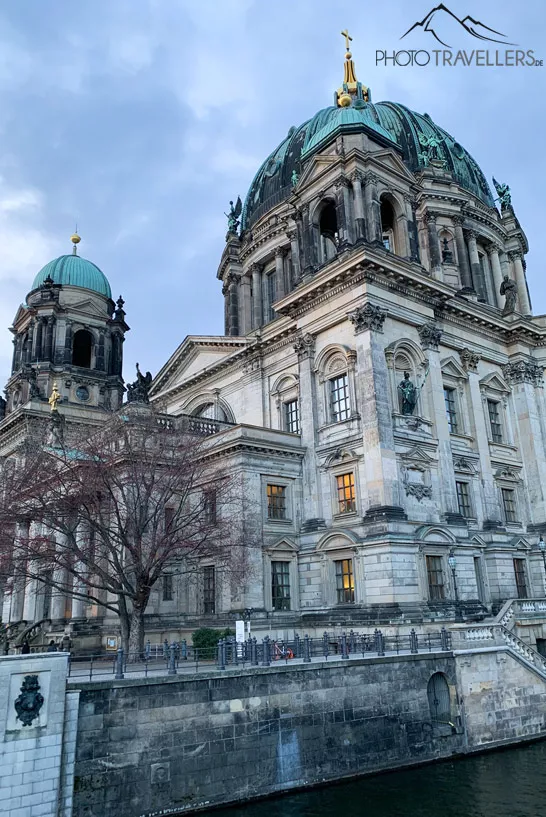 The Berlin Cathedral is located on Museum Island
The Berlin Cathedral is located on Museum Island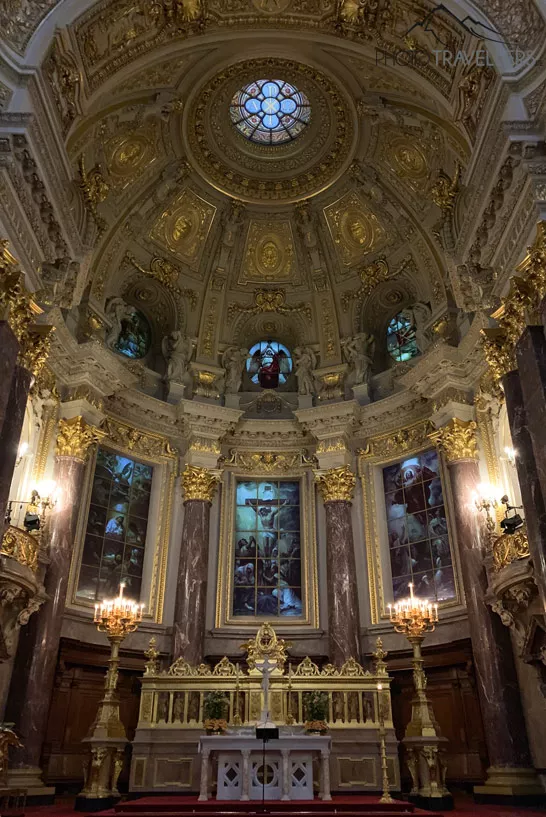 The interior of the church is well worth seeing
The interior of the church is well worth seeing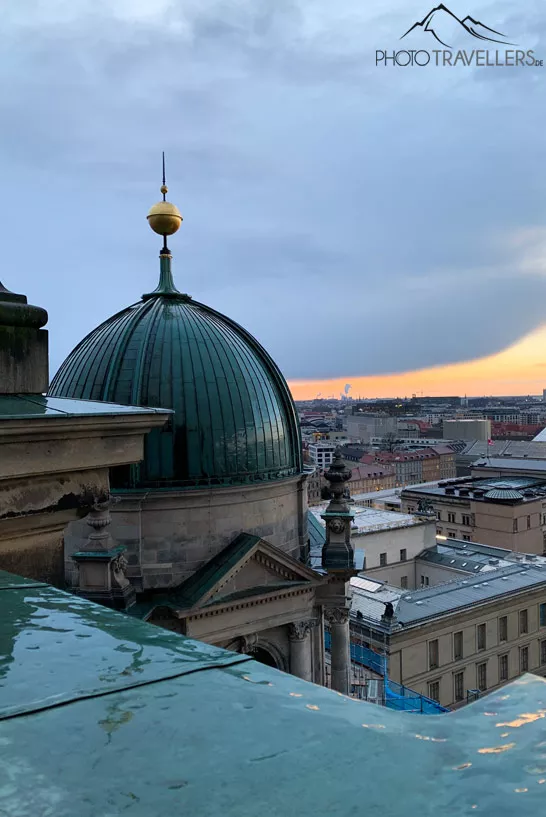 This is the view from Berlin Cathedral at sunset
This is the view from Berlin Cathedral at sunsetOf course, a visit to Berlin Cathedral on Museum Island is also a must. Berlin Cathedral is the largest Protestant church in Germany in terms of area and consists of the large preaching church in the middle and the smaller baptistery and wedding church on the south side.
Berlin Cathedral was destroyed and rebuilt during the Second World War. At least the interior of the church has been faithfully restored. Be sure to go to the observation terrace of the dome at a height of 50 meters. The ascent is a bit sweaty (270 steps). The 360-degree panoramic view makes up for it!
Berlin Cathedral is also one of the most important dynastic burial sites in Europe. The Hohenzollern crypt, in which 94 members of the House of Hohenzollern were buried from the end of the 16th to the beginning of the 20th century, covers almost the entire basement.
9. Unter den Linden
Another absolute “must see” is the 1.5-kilometer-long boulevard “Unter den Linden“, laid out in 1573 as a bridle path and later paved and planted with lime trees (hence the name).
The promenade leads from Pariser Platz with the Brandenburg Gate to the Schlossbrücke with the Humboldt Forum. If you follow Karl-Liebknecht-Straße after Schloßplatz, you will reach Alexanderplatz with the television tower.
Take your time and stroll in at least one direction. You can expect magnificent buildings such as the Berlin State Library, the Humboldt University of Berlin and the Neue Wache, cool stores such as the Berlin Store and the Ampelmann Shop as well as many pretty cafés and restaurants.
A visit to the Madame Tussauds wax museum near Pariser Platz is well worthwhile (book your ticket*). The Bud Spencer Museum is also a crowd-puller. In the museum, you can find out all about the actor’s life and work.
10. Gendarmenmarkt
For us, the Gendarmenmarkt is the most beautiful square in Berlin. Highlights at Gendarmenmarkt include Karl Friedrich Schinkel’s Schauspielhaus , which is used as a concert hall, as well as the German Cathedral and the French Cathedral opposite. You can also visit the concert hall. You can register for a guided tour on the website. The tours last 45 minutes and cost 3 euros.
The German Cathedral houses the parliamentary history exhibition of the German Bundestag. The Huguenot Museum is located in the French Cathedral.
11. Humboldt Forum in the Berlin Palace
A visit to the Humboldt Forum in the rebuilt Berlin Palace is a must on any trip to Berlin. The palace, once the main residence of the Brandenburg electors, burned down in 1945 and was blown up in 1950. After reunification, the Berlin Palace and its façade were reconstructed.
It is extremely impressive to walk through the huge inner courtyards of the castle. The building houses several museum collections from all over the world. You will also find the Ethnological Museum Berlin and the Museum of Asian Art here. Together with the surrounding buildings, Berlin is home to one of the largest contiguous cultural ensembles in the world.
Tip: Even if you’re not interested in the museums in the Humboldt Forum: You have a great view over the city from the publicly accessible roof terrace (admission 3 euros).
12. Checkpoint Charlie
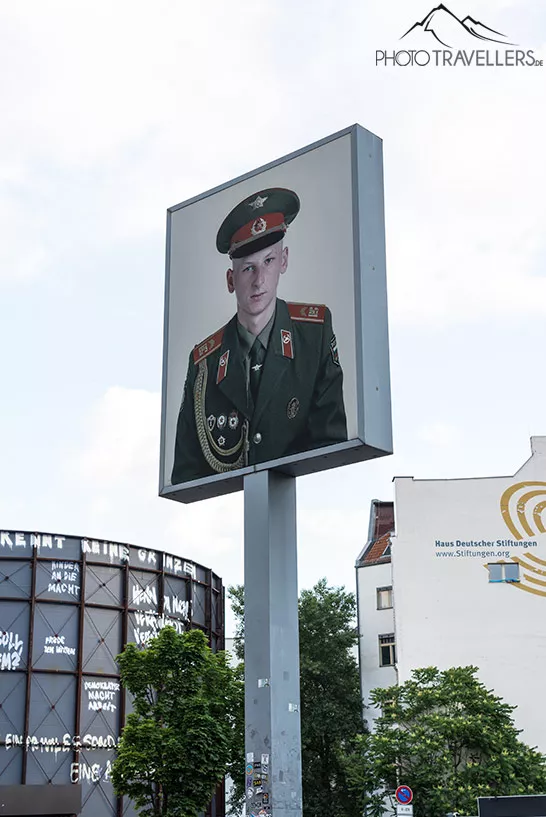 The picture of a soldier at Checkpoint Charlie in Berlin
The picture of a soldier at Checkpoint Charlie in Berlin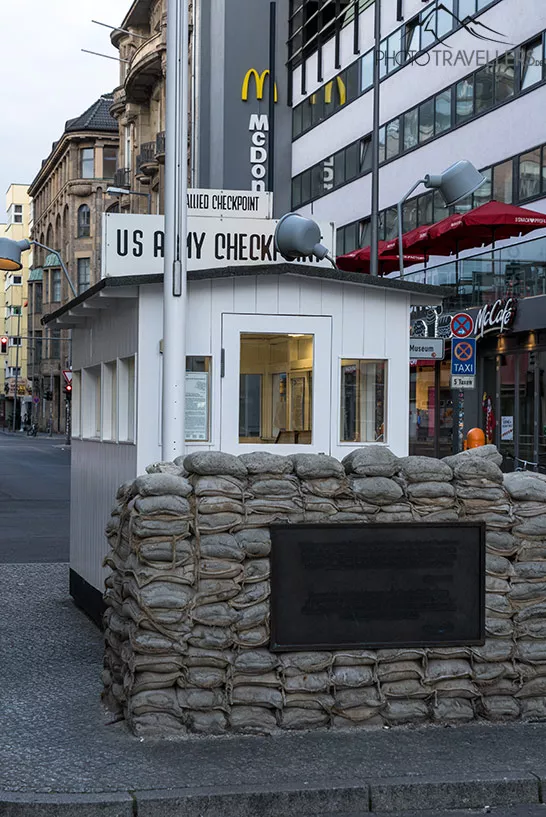 That’s how it was at the time of the division of Berlin – except that there was no way through for normal citizens
That’s how it was at the time of the division of Berlin – except that there was no way through for normal citizens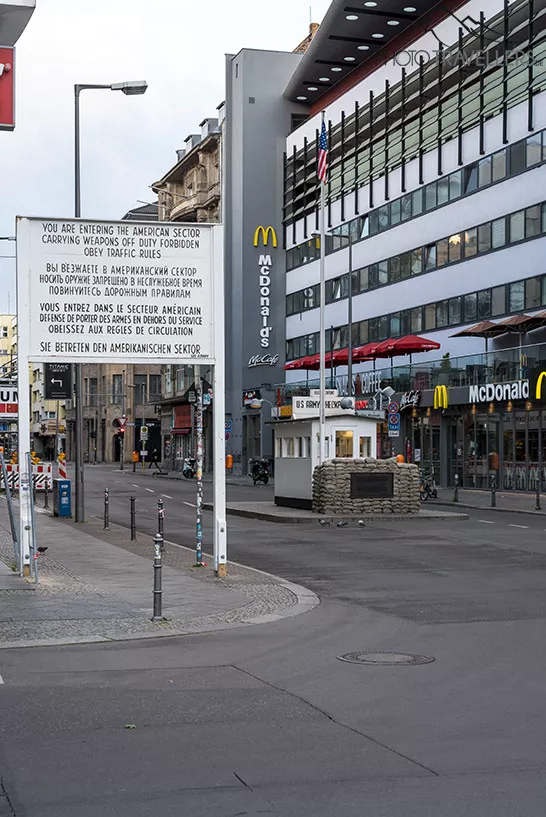 Checkpoint Charlie is located on Friedrichstraße
Checkpoint Charlie is located on FriedrichstraßeCheckpoint Charlie on Friedrichstraße is another famous sight that you shouldn’t miss. The former border crossing point connected the Soviet and US sectors until 1989. Incidentally, the name comes from the international spelling alphabet: After the Alpha and Bravo checkpoints, Charlie was the third and last of the Allied checkpoints used by the Americans.
Today you can find replicas of the control barracks and the information signs here. The two larger-than-life portraits of a Russian and an American soldier are world-famous.
For more information, you should visit the Mauermuseum – Haus am Checkpoint Charlie (book ticket*). The BlackBox Cold War and DIE MAUER – asisi Panorama Berlin are also worth a visit (book your ticket*). On the TimeRide (book ticket*), you can experience a journey through time in Berlin, which is great fun, especially for families with children.
13. Kurfürstendamm
Let’s move on to City-West, or more precisely to Kurfürstendamm ( Ku’damm for short) and its extension, Tauenzienstraße. Berliners often just say“zoo“. This colloquially refers to the entire City West. Why the zoo? Well, this is actually the location of Berlin Zoo, which also gave its name to the famous “Zoologischer Garten” train station.
Ku’damm and Tauenzienstrasse are THE shopping mile in City West. Luxury brands such as Louis Vuitton, Valentino and Gucci await you. Tauenzienstraße is also home to the Europa-Center with the Mercedes star on the roof and the famous KaDeWe (Kaufhaus des Westens) department store. Opened in 1907, KaDeWe is one of the largest department stores in Europe. From the rooftop restaurant of the KaDeWe you have a good view over Tauenzienstraße with the Kaiser Wilhelm Memorial Church and the skyscrapers at the “Zoo”.
At 113 meters, the Kaiser Wilhelm Memorial Church tower was once the tallest in the city until the church was destroyed during the Second World War. The 71-meter-high tower ruins remained standing as a memorial against the war. A modern new building consisting of a nave, church tower, chapel and foyer was erected next to it.
A visit to the Hard Rock Cafe on Ku’damm is highly recommended (book VIP seats including menu here*).
14. Charlottenburg Palace
Our next highlight is Charlottenburg Palace, the former summer residence of the Hohenzollerns in the Charlottenburg district.
The castle is now a popular museum. Here you can see the porcelain cabinet, the red damask chamber, the golden gallery and the palace chapel.
If you are looking for peace and quiet in the urban jungle, take a look at the palace park with the Belvedere, the Mausoleum and the New Pavilion.
You can also listen to the Berlin Residence Orchestra at Charlottenburg Palace (book a ticket*) – or how about a musical dinner in the palace (book a ticket*)?
15. Topography of Terror
With over one million visitors a year, the Topography of Terror is one of the most visited museums in the German capital. The museum takes you on a journey into the dark past of National Socialism in Germany. In our opinion, a visit to the museum should not be missed on any trip to Berlin!
Excursion tip 1: Potsdam
If you’re in Berlin for a longer period of time, it’s worth taking a trip to Potsdam. The capital of Brandenburg enchants with many exciting highlights such as Sanssouci Palace or the media city of Babelsberg. You can reach Potsdam from Berlin city center in 30 to 40 minutes by S-Bahn.
Here you will find an overview of the most important sights in Potsdam.
Excursion tip 2: Spreewald
The Spreewald offers a unique nature experience in Germany. You can expect a landscape that is unique in Central Europe with a 1,575-kilometer network of natural and artificial watercourses, wet meadows, small fields and near-natural lowland forests.
We were totally thrilled during our visit to the Spreewald. Make sure you take a boat trip through the Spreewald.
Where to stay in Berlin? Our hotel tips
The aletto Hotel on Postdamer Platz is a good and relatively cheap place to stay (check price*). The location is perfect for exploring the German capital on foot and by bus and train.
Pure luxury awaits you at the Hotel Adlon Kempinski (check price*) directly at the Brandenburg Gate.
One of the best views over the city awaits you at the luxury hotel Waldorf Astoria Berlin(check price*) at the Zoological Garden.
One of the hottest addresses in the city is currently the 25hours Hotel Bikini Berlin (check price*) on Budapester Strasse in City-West.
We’ve also had a great time at the Pullman Berlin Schweizerhof (check price*), also on Budapester Strasse.
Map with the most important sights in Berlin
You can find an overview of the most important sights in Berlin on our interactive map:
[mapsmarker map=”244″]
So there you have it, the most important sights in Berlin. Do you have any suggestions or further ideas? Let us know in the comments – we’d love to hear from you!
